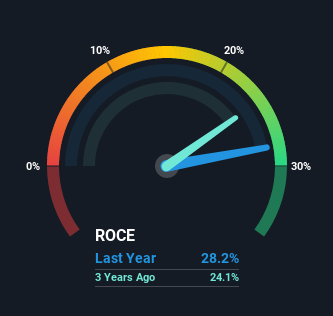BCL Industries (NSE:BCLIND) Knows How To Allocate Capital Effectively

Did you know there are some financial metrics that can provide clues of a potential multi-bagger? Firstly, we'll want to see a proven return on capital employed (ROCE) that is increasing, and secondly, an expanding base of capital employed. If you see this, it typically means it's a company with a great business model and plenty of profitable reinvestment opportunities. Speaking of which, we noticed some great changes in BCL Industries' (NSE:BCLIND) returns on capital, so let's have a look.
Return On Capital Employed (ROCE): What is it?
If you haven't worked with ROCE before, it measures the 'return' (pre-tax profit) a company generates from capital employed in its business. To calculate this metric for BCL Industries, this is the formula:
Return on Capital Employed = Earnings Before Interest and Tax (EBIT) ÷ (Total Assets - Current Liabilities)
0.28 = ₹1.1b ÷ (₹6.1b - ₹2.2b) (Based on the trailing twelve months to December 2021).
Thus, BCL Industries has an ROCE of 28%. In absolute terms that's a great return and it's even better than the Food industry average of 13%.
Check out our latest analysis for BCL Industries

While the past is not representative of the future, it can be helpful to know how a company has performed historically, which is why we have this chart above. If you're interested in investigating BCL Industries' past further, check out this free graph of past earnings, revenue and cash flow.
What Can We Tell From BCL Industries' ROCE Trend?
Investors would be pleased with what's happening at BCL Industries. The data shows that returns on capital have increased substantially over the last five years to 28%. The amount of capital employed has increased too, by 112%. So we're very much inspired by what we're seeing at BCL Industries thanks to its ability to profitably reinvest capital.
On a related note, the company's ratio of current liabilities to total assets has decreased to 37%, which basically reduces it's funding from the likes of short-term creditors or suppliers. So shareholders would be pleased that the growth in returns has mostly come from underlying business performance.
What We Can Learn From BCL Industries' ROCE
A company that is growing its returns on capital and can consistently reinvest in itself is a highly sought after trait, and that's what BCL Industries has. And with the stock having performed exceptionally well over the last year, these patterns are being accounted for by investors. In light of that, we think it's worth looking further into this stock because if BCL Industries can keep these trends up, it could have a bright future ahead.
On a separate note, we've found 2 warning signs for BCL Industries you'll probably want to know about.
BCL Industries is not the only stock earning high returns. If you'd like to see more, check out our free list of companies earning high returns on equity with solid fundamentals.
Valuation is complex, but we're here to simplify it.
Discover if BCL Industries might be undervalued or overvalued with our detailed analysis, featuring fair value estimates, potential risks, dividends, insider trades, and its financial condition.
Access Free AnalysisHave feedback on this article? Concerned about the content? Get in touch with us directly. Alternatively, email editorial-team (at) simplywallst.com.
This article by Simply Wall St is general in nature. We provide commentary based on historical data and analyst forecasts only using an unbiased methodology and our articles are not intended to be financial advice. It does not constitute a recommendation to buy or sell any stock, and does not take account of your objectives, or your financial situation. We aim to bring you long-term focused analysis driven by fundamental data. Note that our analysis may not factor in the latest price-sensitive company announcements or qualitative material. Simply Wall St has no position in any stocks mentioned.
About NSEI:BCLIND
BCL Industries
Engages in the edible oil and distillery businesses in India and South Asian region.
Adequate balance sheet second-rate dividend payer.
Market Insights
Community Narratives





